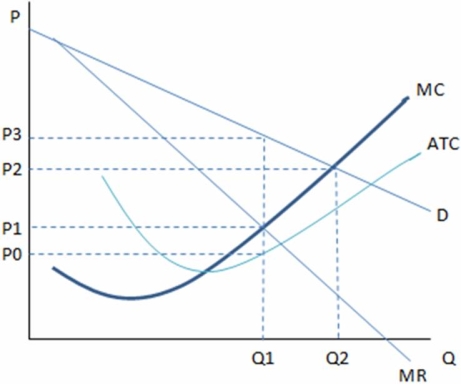A) eliminates all consumer surplus.
B) maximizes producer surplus.
C) creates no deadweight loss.
D) All of these statements are true.
Correct Answer

verified
Correct Answer
verified
Multiple Choice
One barrier to entry into a monopoly market is:
A) very large fixed costs relative to variable costs.
B) the existence of large economies of scale.
C) the high cost of required infrastructure for an industry.
D) All of these statements are true.
Correct Answer

verified
Correct Answer
verified
Multiple Choice
Some argue that the best response to monopolies is no response at all,because:
A) they are too powerful to be dealt with effectively.
B) no one can ever decide which monopolies to regulate.
C) the creation of regulation may be too difficult.
D) left unchecked, all monopolies eventually shut down.
Correct Answer

verified
Correct Answer
verified
Multiple Choice
The public policies designed to mitigate the effects of monopolies are:
A) highly debated issues.
B) well-defined and accepted.
C) highly effective.
D) proven to increase benefits more than increase costs.
Correct Answer

verified
Correct Answer
verified
Multiple Choice
Public policy responses to monopolies:
A) could aim to break up existing monopolies.
B) always have more costs than benefits to society.
C) always have more benefits than costs to society.
D) never benefit society in the end.
Correct Answer

verified
Correct Answer
verified
Multiple Choice
The regulation of natural monopolies:
A) typically takes the form of setting a maximum price that can be charged.
B) always causes the industry to operate at a loss.
C) eliminates deadweight loss.
D) is common in the tobacco industry.
Correct Answer

verified
Correct Answer
verified
Multiple Choice
This graph shows the cost and revenue curves faced by a monopoly.  According to the graph shown,if Q1 units are being produced,this monopolist should:
According to the graph shown,if Q1 units are being produced,this monopolist should:
A) increase production.
B) charge P0 to maximize profits.
C) charge P1 to maximize profits.
D) charge P3 to maximize profits.
Correct Answer

verified
Correct Answer
verified
Multiple Choice
One of the key reasons why monopolies exist is:
A) there is easy entry and exit into and out of the market.
B) the goods sold are highly inaccessible to buyers.
C) there are barriers to entry into the market.
D) geographical differences.
Correct Answer

verified
Correct Answer
verified
Multiple Choice
For a monopoly,for all units greater than one,the marginal revenue curve:
A) lies above the demand curve.
B) lies below the average revenue curve.
C) cannot be negative.
D) All of these statements are true.
Correct Answer

verified
Correct Answer
verified
Multiple Choice
To avoid subsidies,the government should cap the price for natural monopolies at their:
A) marginal cost.
B) average total cost.
C) average variable cost.
D) fixed cost.
Correct Answer

verified
Correct Answer
verified
Multiple Choice
A natural monopolist that sets prices equal to marginal cost will:
A) incur losses.
B) have zero profit.
C) still make a positive economic profit.
D) be government owned.
Correct Answer

verified
Correct Answer
verified
Multiple Choice
This table represents the revenues faced by a monopolist.  Using the information in the table shown,the marginal revenue:
Using the information in the table shown,the marginal revenue:
A) increases, then decreases as output increases.
B) is negative after the 6th unit.
C) increases as output increases.
D) decreases, then increases after the 6th unit.
Correct Answer

verified
Correct Answer
verified
Multiple Choice
When a monopolist chooses the level of output where marginal cost equals marginal revenue:
A) profits are maximized.
B) price is set at marginal revenue.
C) price is equal to average total costs.
D) total revenue is maximized.
Correct Answer

verified
Correct Answer
verified
Multiple Choice
The government has used the Sherman Act to break up monopolies in which of the following industries?
A) Tobacco
B) Fishing
C) Trucking
D) Coal
Correct Answer

verified
Correct Answer
verified
Multiple Choice
In general,with a monopolist's outcome,total surplus is:
A) higher than that of a competitive market.
B) lower than that of a competitive market.
C) the same as that of a competitive market.
D) Any of these is possible.
Correct Answer

verified
Correct Answer
verified
Multiple Choice
At any price the monopolist sets,it will sell:
A) as many as it wants.
B) as many as demanders are willing to buy.
C) more than a perfectly competitive market would sell.
D) less than quantity demanded to keep the item rare.
Correct Answer

verified
Correct Answer
verified
Multiple Choice
For a monopoly,marginal revenue for all units greater than 1:
A) is always less than the price.
B) cannot be negative.
C) is zero when total profits are maximized.
D) is always greater than marginal cost.
Correct Answer

verified
Correct Answer
verified
Multiple Choice
Antitrust activities can cause inefficiencies by:
A) breaking up a natural monopoly.
B) creating many small firms that cannot capture available economies of scale.
C) Both of these statements are true.
D) Neither of these statements is true.
Correct Answer

verified
Correct Answer
verified
Multiple Choice
When government agencies become privatized:
A) they are sold to private companies.
B) stock is created and sold to the public.
C) private stock is sold to private households.
D) they are rarely regulated.
Correct Answer

verified
Correct Answer
verified
Multiple Choice
The monopolist faces a:
A) perfectly elastic demand curve.
B) downward sloping demand curve.
C) perfectly inelastic demand curve.
D) perfectly elastic supply curve.
Correct Answer

verified
Correct Answer
verified
Showing 41 - 60 of 146
Related Exams